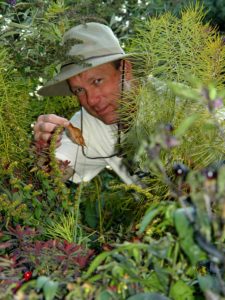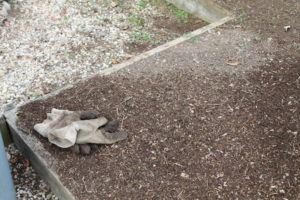10 End-of-Season Yard Jobs
October 19th, 2021
As the curtain closes on a wet and buggy 2021 gardening season, it’s time to do a few things that fall under the category of so-called “putting your yard to bed.”

There’s no need to remove every last leaf from the yard in fall.
If you don’t already have your own list, here are 10 season-ending, winter-prepping yard jobs.
1.) Clean but don’t “sanitize.” It makes sense to get rid of diseased or bug-ridden foliage and excessive leaves that threaten to smother the lawn and groundcover beds, but you don’t have to remove every last bit of organic debris from the yard.
Consider leaving the leaves at the base of trees and shrubs, around dormant perennials, and over top of bare annual-flower and vegetable gardens.
Mow light layers of leaves right into the lawn.
And for heavier leaf layers that threaten to mat down the lawn or evergreen groundcovers, gather them, chop them, and add them to your compost pile.
Read George’s past leaf post on “Love ‘em and leave ‘em”
2.) Yank the dead stuff. Frost-killed annuals and vegetables can be pulled and composted – if they’re not diseased. If they are diseased, bag and toss them.
3.) Clip the browned-out perennial flowers. Perennials that have died back can be cut and the foliage composted as well.
However, consider leaving some plants stand that provide food for birds over winter, such as black-eyed susans, coneflowers, liatris, sedum, and sunflowers.
4.) “Top-dress” the gardens with compost. After pulling any weeds and spent plants, top the vegetable garden and annual-flower beds with a season-ending inch of compost or chopped leaves.

A layer of compost can go right on top of vegetable and annual-flower gardens at season’s end.
That layer will add nutrition as well as protect otherwise bare soil from winter erosion. No need to till it in.
5.) One last grass cut. Cut your lawn shorter than usual for the final cut of the year, which reduces the odds of early-spring fungal diseases such as snow mold and gray mold.
This doesn’t mean scalp. It means lowering the blade from the in-season height of three to four inches to about one-and-a-half to two inches for the final cut.
If the clips are so many that they’re creating piles, add them to the compost or use them to top garden beds (assuming the grass hasn’t been treated with herbicides).
6.) Fertilize the lawn. Turfgrass researchers say a mid-fall fertilization may be the season’s most important. Reason: the fertilizer will break down over winter and be in the root zone ready for the grass to use as soon as the soil warms next spring.
Use a slow-to-break-down organic fertilizer or a chemical one that’s high in “slow-release” nitrogen. (Labels usually specify.)
7.) Protect the tender stuff. Plants that are borderline hardy in our climate (especially evergreen ones) benefit from some wind protection over winter.

Erect burlap barriers around plants instead of wrapping the burlap directly onto them.
Burlap barriers are as good as anything for creating a temporary, inexpensive windbreak.
Hammer stakes in the ground around your plants, and wrap sheets of burlap (available in most garden centers) around them as opposed to draping the fabric directly over the plants.
Anti-transpirant sprays or “anti-desiccants” (common brands are Wilt-Pruf, Wilt Stop, and No Wilt Plant Shield) haven’t been found to help with cold protection. They’re primarily useful in reducing the transplant shock of moving plants during the growing season, not winter protection.
8.) Check the mulch. Mulch acts like a blanket to keep the soil slightly warmer and damper. Only snow is a better winter insulator.
Two inches is fine over perennial beds, and three inches is ideal over tree, shrub, and evergreen beds. If you don’t have that amount, now is still a good time to apply it.
Mulch also moderates swings in soil temperature, which reduces episodes of freezing and thawing that can push the root balls of young plants up from the ground.
Keep the mulch a few inches back away from trunks and stems.
9.) Keep the soil damp. Root growth continues even after the season’s first frost, generally up until the soil temperature at root level goes down to about 40 degrees. If the ground goes bone dry in fall after you’ve put away the hose, plants head into winter already suffering from moisture stress.
Keep the hose handy, and especially keep new plantings damp right up until the ground freezes.
10.) Head off animal damage. Get the fences up or the repellent sprays on your vulnerable landscape plants. Landscape plant damage goes up in winter as deer, rabbits, and voles turn to what’s still green as their other choices disappear.
Besides installing fencing to guard against deer, consider cardboard or plastic-spiral tree wraps around your young tree trunks to prevent rabbits and rodents from gnawing on tender bark. Go up high enough with wraps on the trunk to account for snow cover that can serve as a feeding platform. Even three feet up is not too high.
Read more on how to defend plants against deer damage







